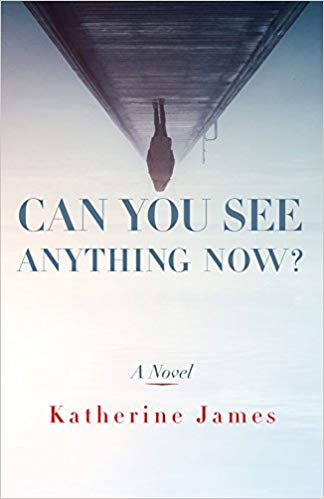by Jessica Dundas
The label “Christian Fiction” tends to turn me off. I expect another cleaned up, simplified version of life, where they always get their miracle and every sunset reminds us that God is good. Cheesy clichés, sub-par writing. But that is not at all what Katherine James has given us in her novel Can You See Anything Now? In lyrical prose she has gone straight to the gritty side of life, addressing suicide, drug abuse, and self-harm—topics too often brushed over or explained away in lesser Christian fiction. Paraclete launched its new fiction line with this novel, daring to redefine the genre.
The book opens with an unfortunately public suicide attempt in the small town of Trinity. Margie Nethercott, an artist, tries to drown herself in the lake by tying a large rock to her ankle, but the water turns out to be too shallow and she is left bobbing, waiting for the sun to rise and the neighborhood runners to come out. The story unfolds from there, weaving small town lives together, getting into the heads of various characters and giving us a kaleidoscope of the struggles we’re afraid to address in church.

Another artist in town, Etta, is reading The Five Love Languages and Christian sex books and trying to move on from all her paintings of tomatoes to painting rooftops. But when she hears about Margie, she decides that rather than avoid the woman, she will introduce herself. In return, Margie introduces her to art classes and painting nudes. Etta is pushed far out of her comfort zone, but faces it all with relentless optimism. She is determined not to run away from the struggling.
Margie’s husband is a therapist—too busy diagnosing to give an understanding ear—and their daughter Noel is off at college in New York with a roommate, Pixie, who is struggling with drug addiction and cutting. When Pixie comes to visit for Thanksgiving, she brings all her pain with her. Noel is also working through an on-and-off relationship with her high school sweetheart Owen. They don’t always know how to act around Margie, or around town where everyone knows everybody’s business. They’re just trying to work through living in a world that’s a lot less stable than it used to seem.
This book burned in the back of my mind long after turning the last page. The characters left vivid images: the canvases Margie painted, the ridges of the scars on Pixie’s arms, the rocking chair Etta sat in to enjoy her view of Trinity rooftops. Wondering what it would be like to be found bobbing in the middle of the lake by your neighbor, unable to hide what you’ve attempted to do. Pixie’s father Pete learning to pray in a hospital room. I was unable to walk away unscathed. Yet it brought deep relief to know that someone is talking about these things.
James describes her novel as one in which you will find redemption if you seek it, but if you’re not looking you won’t see it. Margie doesn’t miraculously recover from her depression, the mess of life in Trinity doesn’t end tied up with a pretty bow. This is not the sanitized reality of ordinary Christian fiction, yet it still functions under that label as it begs the reader to bring this mess of life to God. James dares to address real issues and show the reality that they don’t always get their miracle, unsettling the norms of the genre and challenging the reader to address these issues as well.
